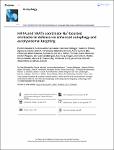HIF1A and NFAT5 coordinate Na+-boosted antibacterial defense via enhanced autophagy and autolysosomal targeting
Neubert, Patrick
Weichselbaum, Andrea
Reitinger, Carmen
Schatz, Valentin
Schröder, Agnes
Ferdinand, John R.
Simon, Michaela
Bär, Anna-Lorena
Brochhausen, Christoph
Gerlach, Roman G.
Tomiuk, Stefan
Hammer, Karin
Wagner, Stefan
van Zandbergen, Ger
Binger, Katrina J.
Müller, Dominik N.
Kitada, Kento
Clatworthy, Menna R.
Kurts, Christian
Titze, Jens
Abdullah, Zeinab
Jantsch, Jonathan
Infection and inflammation are able to induce diet-independent Na+-accumulation without commensurate water retention in afflicted tissues, which favors the pro-inflammatory activation of mouse macrophages and augments their antibacterial and antiparasitic activity. While Na+-boosted host defense against the protozoan parasite Leishmania major is mediated by increased expression of the leishmanicidal NOS2 (nitric oxide synthase 2, inducible), the molecular mechanisms underpinning this enhanced antibacterial defense of mouse macrophages with high Na+ (HS) exposure are unknown. Here, we provide evidence that HS-increased antibacterial activity against E. coli was neither dependent on NOS2 nor on the phagocyte oxidase. In contrast, HS-augmented antibacterial defense hinged on HIF1A (hypoxia inducible factor 1, alpha subunit)-dependent increased autophagy, and NFAT5 (nuclear factor of activated T cells 5)-dependent targeting of intracellular E. coli to acidic autolysosomal compartments. Overall, these findings suggest that the autolysosomal compartment is a novel target of Na+-modulated cell autonomous innate immunity.
Dateien zu dieser Publikation

